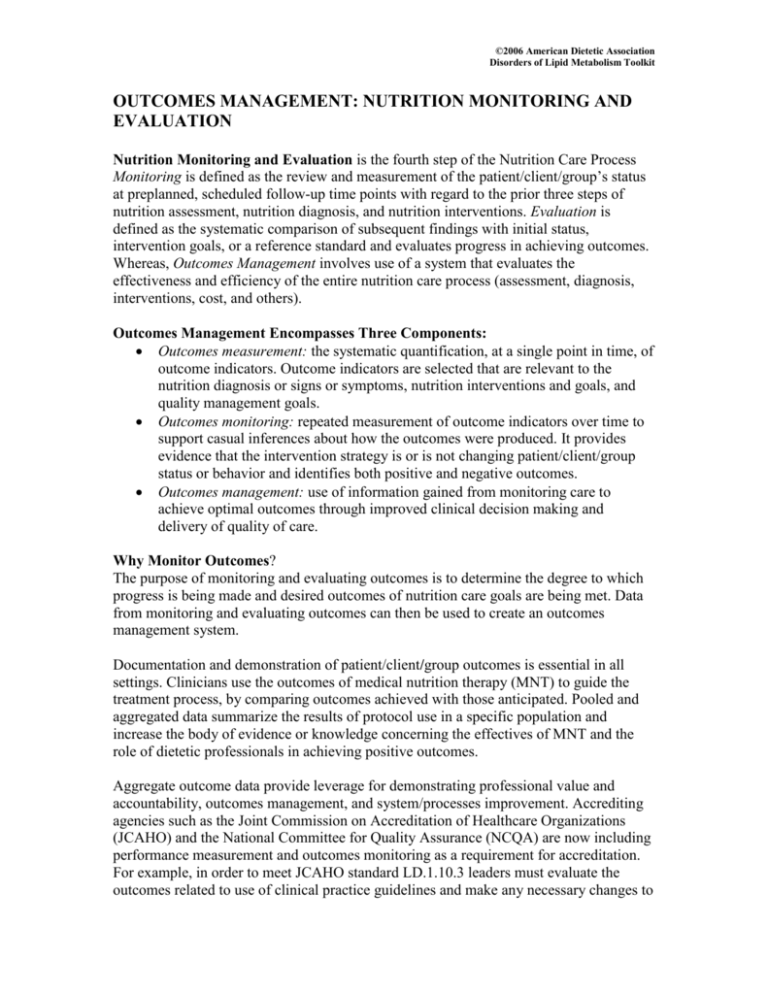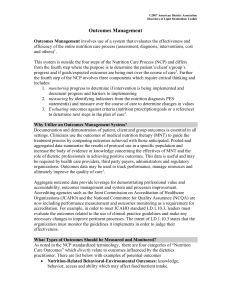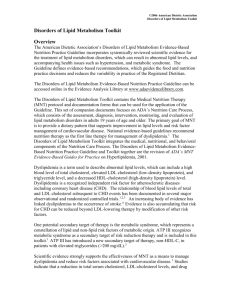outcomes management: nutrition monitoring and evaluation
advertisement

©2006 American Dietetic Association Disorders of Lipid Metabolism Toolkit OUTCOMES MANAGEMENT: NUTRITION MONITORING AND EVALUATION Nutrition Monitoring and Evaluation is the fourth step of the Nutrition Care Process Monitoring is defined as the review and measurement of the patient/client/group’s status at preplanned, scheduled follow-up time points with regard to the prior three steps of nutrition assessment, nutrition diagnosis, and nutrition interventions. Evaluation is defined as the systematic comparison of subsequent findings with initial status, intervention goals, or a reference standard and evaluates progress in achieving outcomes. Whereas, Outcomes Management involves use of a system that evaluates the effectiveness and efficiency of the entire nutrition care process (assessment, diagnosis, interventions, cost, and others). Outcomes Management Encompasses Three Components: Outcomes measurement: the systematic quantification, at a single point in time, of outcome indicators. Outcome indicators are selected that are relevant to the nutrition diagnosis or signs or symptoms, nutrition interventions and goals, and quality management goals. Outcomes monitoring: repeated measurement of outcome indicators over time to support casual inferences about how the outcomes were produced. It provides evidence that the intervention strategy is or is not changing patient/client/group status or behavior and identifies both positive and negative outcomes. Outcomes management: use of information gained from monitoring care to achieve optimal outcomes through improved clinical decision making and delivery of quality of care. Why Monitor Outcomes? The purpose of monitoring and evaluating outcomes is to determine the degree to which progress is being made and desired outcomes of nutrition care goals are being met. Data from monitoring and evaluating outcomes can then be used to create an outcomes management system. Documentation and demonstration of patient/client/group outcomes is essential in all settings. Clinicians use the outcomes of medical nutrition therapy (MNT) to guide the treatment process, by comparing outcomes achieved with those anticipated. Pooled and aggregated data summarize the results of protocol use in a specific population and increase the body of evidence or knowledge concerning the effectives of MNT and the role of dietetic professionals in achieving positive outcomes. Aggregate outcome data provide leverage for demonstrating professional value and accountability, outcomes management, and system/processes improvement. Accrediting agencies such as the Joint Commission on Accreditation of Healthcare Organizations (JCAHO) and the National Committee for Quality Assurance (NCQA) are now including performance measurement and outcomes monitoring as a requirement for accreditation. For example, in order to meet JCAHO standard LD.1.10.3 leaders must evaluate the outcomes related to use of clinical practice guidelines and make any necessary changes to ©2006 American Dietetic Association Disorders of Lipid Metabolism Toolkit improve pertinent processes. The intent of LD.1.10.3 states that the organization must monitor the guidelines it implements in order to judge their effectiveness. What Types of Outcomes Should be Measured and Monitored? The nutrition care process recommends that the outcomes to be measured and monitored should be directly related to the nutrition diagnosis and the nutrition intervention goals The following four categories are listed with examples of potential outcomes (but not limited to those listed) that could be collected related to each category. Direct nutrition intervention outcomes such as knowledge gained, behavior change, food or nutrient changes, improved nutritional status. Clinical and health status outcomes such as laboratory values, weight, blood pressure, risk factor profile changes, signs and symptoms, clinical status, infections, complications. Patient/client-centered outcomes such as quality of life, satisfaction, self-efficacy, self-management, functional ability. Health care utilization and cost outcomes such as medication changes, special procedures, planned/unplanned clinic visits, preventable hospitalizations, length of hospitalization, prevent or delay nursing home admission. How is Data Collected? Potential outcomes from each evidence-based nutrition practice guideline needs to be identified, listed in the appropriate category, measured, and then aggregated. To do this, several collection forms and tools have been developed, including a request and authorization for release of patient information. Request and authorization for release of patient information. Before collecting patient/client data, a signed confidentiality statement similar to the one included needs to be signed by each individual. Example of a worksheet for collection of individual outcomes. The worksheet is available for download. Before entering data on the Individual Outcome sheet, photocopy the sheet one or more times for additional patients/clients. Example of group outcomes input sheet and group outcome summary. The worksheet is set up for 10 patients/clients. Additional rows can be added as needed. Directions for Using Excel Worksheets to Monitor Outcomes Data This workbook has three sheets: Individual Outcomes Monitoring, Aggregate Input Form and Aggregate Outcomes Monitoring. You will also find three sample monitoring forms which are based on the case studies in this Toolkit. The tabs on the bottom let you move around to the different sheets. Click on the tab and it will go from gray to white. If the gray is not visible, that is the sheet you can input data. When there is not data entered you will see things like #DIV/0! or ####. This is because of the formulas. Numbers will replace these once you input your raw data. ©2006 American Dietetic Association Disorders of Lipid Metabolism Toolkit Some information that should not be change: Formulas and items are protected so that you will not delete them by accident. The places you need to input data are not protected and you can add and change data. Before you enter data on the Individual Outcome sheet, you need to duplicate the sheet one or more times for additional clients. You can duplicate the Individual Outcomes Monitoring Form worksheet either by just printing off a blank sheet or by adding all your clients to this workbook. To add a copy of the Individual Outcomes worksheet to the workbook: Go to the sheet, then click on the toolbar. Go down to Move or copy sheet and click on the then at the bottom of the box check create a copy and say OK. Next you will need to go down to the tab and click on it to highlight and then name the sheet. Adding more clients to the Aggregate Input Form: This worksheet is currently set for 10 clients. For additional clients, you will need to add more rows to this sheet. First you will need to unprotect this worksheet. To do this by going to the tool bar and click on tools, the click on protection. Chose unprotect sheet. You can add a row(s) by pointing and clicking on the number 15 at the far left of the worksheet. This will highlight the whole row, then go the toolbar and click insert. This will insert a row. You can repeat this and add as many rows as you wish. VERY IMPORTANT! Before you leave a worksheet you need to go back and protect the worksheet again. This is your safe guard for not deleting formulas. To protect the worksheet, go back to the tool bar and click on tools, the click on protection. Choose protect sheet. When the box comes up giving you options of protecting contents objects and scenarios, and all three are checked. Leave the password blank. Then click OK. You do not need to enter data on the Aggregate Outcomes Form. This pulls data from the other sheets. Review the information above to improve data collection. Good data collection strategies are imperative. 1. Lacey K, Pritchard E. Nutrition care process and model: ADA adopts road map to quality care and outcomes management. J Am Diet Assoc 2003;103:10611072. Information for the above text was adapted from reference 1. Data Privacy and Security It is important that a confidentiality statement like the following be attached to all data reports shared at a site. o CONFIDENTIAL: This document has been prepared for review and evaluation by the ______________________ Committee and is entitled to the protection of the peer review, medical review, quality assurance, or other similar privileges provided for by state and federal law. It is not to be copied or distributed without the express, written consent of the legal department. ©2006 American Dietetic Association Disorders of Lipid Metabolism Toolkit A written patient consent must be obtained before sharing any data. The following is an example informed consent form. o REQUEST & AUTHORIZATION FOR RELEASE OF PATIENT INFORMATION I, hereby authorize the release (patient’s name) of all relevant data in my patient records to the ….. I understand that I will receive a copy of this consent form if requested. Client (Parent/Guardian) Signature Date Witness Signature Date








